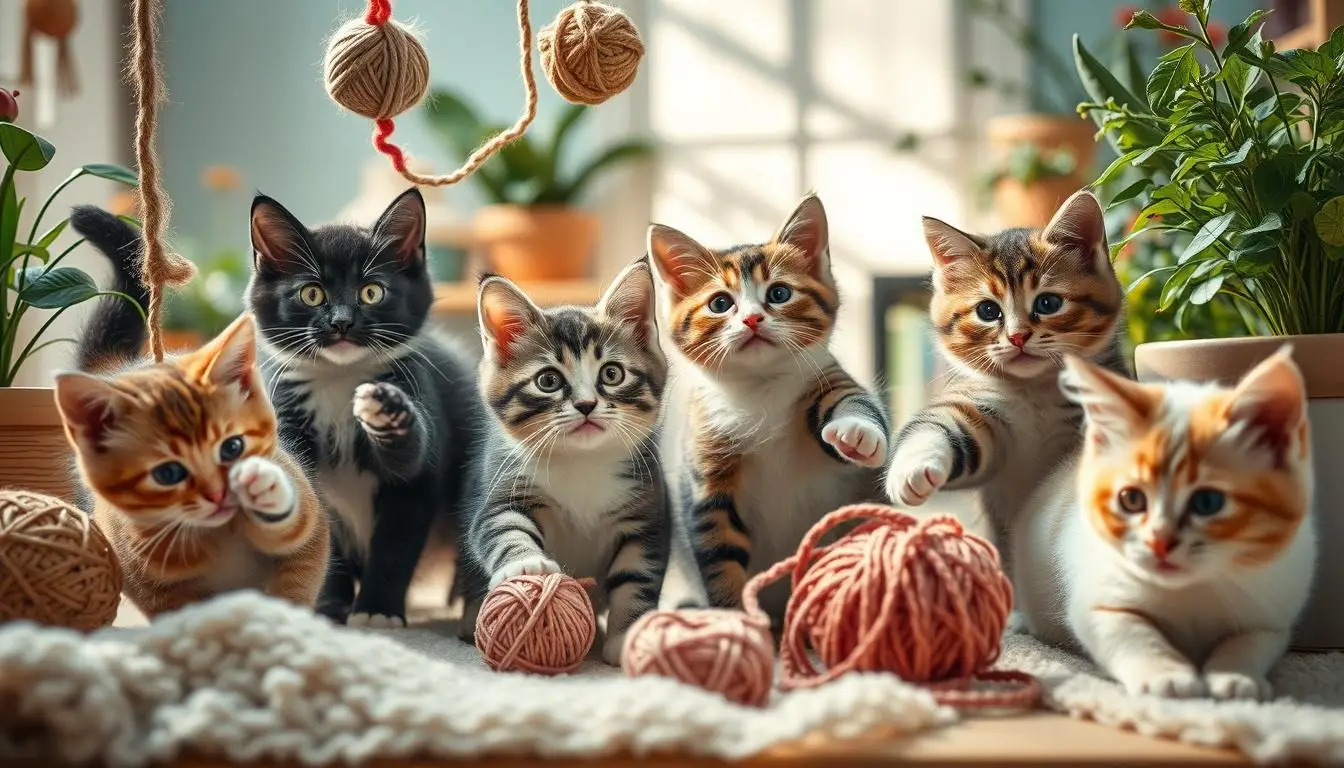
Every cat owner knows the delightful chaos that comes with living with mischievous felines. These furry troublemakers have an uncanny ability to turn ordinary moments into hilarious adventures. Naughty cats possess a unique talent for creating mayhem that simultaneously frustrates and entertains their human companions.
From toppling carefully arranged decorations to midnight zoomies across the living room, these playful creatures transform homes into unpredictable playgrounds. Their mischievous behavior isn’t just random chaos—it’s a complex expression of their natural instincts and personality.
Cat lovers worldwide understand that beneath the naughty cat’s destructive antics lies an adorable and intelligent creature seeking interaction, stimulation, and attention. Whether they’re stealing socks, investigating kitchen counters, or creating elaborate escape plans, these furry companions never fail to surprise us.
Key Takeaways
- Naughty cats exhibit behaviors rooted in natural instincts
- Mischievous felines use playfulness as a communication tool
- Cat behavior is complex and often entertaining
- Understanding cat psychology helps manage their antics
- Playful destruction is often a sign of high intelligence
Understanding Why Cats Engage in Mischievous Behavior
Naughty cats aren’t simply trying to drive their owners crazy. These troublesome pets actually have deep-rooted biological reasons for their seemingly random and destructive behaviors. Understanding the motivations behind their antics can help pet owners develop more compassionate and effective strategies for managing their feline friends.
Cats are complex creatures with intricate behavioral patterns that stem from their evolutionary history. Their actions might seem random, but they typically serve specific survival-driven purposes.
Natural Hunting Instincts
Domestic cats retain powerful hunting instincts from their wild ancestors. These naughty cats frequently demonstrate their predatory skills through:
- Pouncing on moving objects
- Chasing small toys
- Stalking household items
- Practicing ambush techniques
Territory Marking Tendencies
Troublesome pets like cats are incredibly territorial. Their seemingly destructive behaviors often represent complex communication strategies. Scratching furniture, spraying, and rubbing against objects are ways cats establish and maintain their personal space.
Attention-Seeking Behaviors
Cats are masters of manipulation. When they feel neglected, these intelligent animals will intentionally engage in provocative actions to capture their owner’s attention. Knocking items off shelves, meowing loudly, or interrupting work are common tactics used by these clever creatures.
By recognizing the underlying motivations of naughty cats, owners can transform frustrating moments into opportunities for better understanding and bonding with their feline companions.
Common Destructive Habits of Troublesome Pets
Cats are notorious for their mischievous behavior, and troublesome pets can turn your home into a playground of chaos. Destructive kittens often develop habits that can drive pet owners crazy, transforming peaceful living spaces into potential disaster zones.
Some of the most common destructive behaviors include:
- Furniture Scratching: Cats naturally need to sharpen their claws, which can result in shredded sofas and damaged furniture
- Knocking over household objects
- Chewing on electrical cords
- Unraveling toilet paper rolls
- Climbing curtains
These troublesome pets aren’t trying to be malicious. Their behaviors stem from natural instincts, boredom, or a need for attention. Destructive kittens often lack proper mental and physical stimulation, which leads them to create their own entertainment.
Potential risks of these behaviors include:
- Damage to expensive household items
- Potential injury to the cat
- Electrical hazards from cord chewing
- Increased stress for pet owners
“Understanding your cat’s behavior is the first step in managing their destructive tendencies.”
Recognizing these patterns early can help pet owners develop strategies to redirect their cat’s energy and protect their home from potential damage.
When Unruly Cat Behavior Becomes Entertainment
Cat owners know that naughty cats are never boring. Unruly cat behavior can transform ordinary moments into hilarious experiences that keep us laughing and entertained. While these mischievous antics might sometimes test our patience, they ultimately reveal the playful and unpredictable nature of our feline friends.
Midnight Zoomies: Feline Energy Explosions
Every cat owner has experienced the infamous midnight zoomies. These sudden bursts of energy transform peaceful nights into chaotic racing sessions. Naughty cats dart around the house, leaping on furniture, sliding across floors, and creating unexpected soundtracks of mayhem.
- Typical zoomie triggers include:
- Pent-up energy
- Hunting instincts
- Random excitement
Counter Surfing Adventures
Unruly cat behavior reaches new heights during counter surfing escapades. Cats seem magnetically drawn to kitchen counters, exploring forbidden territories with remarkable stealth and curiosity. Their acrobatic moves and strategic food theft attempts can be both frustrating and incredibly amusing.
Paper Roll Destruction
Perhaps the most classic display of naughty cats’ mischief is their fascination with paper rolls. Toilet paper and paper towel rolls become instant toys, quickly transformed into shredded masterpieces. What starts as potential annoyance often becomes an unexpected source of entertainment for cat owners.
*”Cats don’t just play with paper rolls – they deconstruct them with artistic precision!”*
Naughty Cats and Their Furniture Fascination

Naughty cats have a unique relationship with home furniture that often leaves owners both frustrated and amused. These mischievous felines possess an uncanny ability to turn your living room into their personal playground, transforming couches, curtains, and shelves into their ultimate conquest zones.
The furniture fascination of cats stems from several deeply ingrained instincts:
- Territorial marking through scratching
- Stretching and muscle maintenance
- Seeking elevated observation points
- Exploring their environment
Scratching is particularly important for these naughty cats. When they drag their claws across your favorite armchair, they’re not just being destructive. They’re actually communicating and maintaining their physical health. The action helps them remove old claw sheaths, mark their territory with scent glands, and stretch their muscles.
Vertical surfaces like curtains and bookshelves become irresistible climbing challenges for mischievous felines. Their natural athleticism drives them to explore every possible surface, turning your carefully arranged home decor into an exciting obstacle course.
“Cats don’t see furniture as off-limits – they see it as an opportunity for adventure!” – Feline Behavior Expert
To protect your furniture while respecting your cat’s natural behaviors, consider providing scratching posts, climbing trees, and interactive toys that redirect their energy and curiosity.
Kitchen Counter Chronicles: Tales of Mischievous Felines
Cats are notorious explorers, transforming kitchen spaces into their personal playgrounds. These mischievous felines turn ordinary countertops into exciting adventure zones, leaving owners both amused and exasperated by their troublesome pets’ antics.
Food Theft Operations
Cats have perfected the art of stealth when it comes to food acquisition. Their strategic approaches include:
- Silent stalking near food preparation areas
- Quick paw swipes during meal preparation
- Sudden leaps onto countertops
- Distraction techniques to divert human attention
*A watched pot may never boil, but an unattended plate is always fair game for a cat.*
Sink Water Adventures
Kitchen sinks represent an irresistible playground for curious cats. These troublesome pets demonstrate an inexplicable fascination with running water, often performing elaborate water-based rituals.
| Cat Sink Behavior | Typical Actions |
|---|---|
| Drinking Preferences | Preferring moving water over stationary bowl water |
| Exploration Tactics | Pawing at water stream, watching droplets fall |
| Playful Interactions | Splashing water, chasing droplets |
Appliance Investigation Teams
Kitchen appliances become intriguing puzzles for mischievous felines. Their curiosity knows no bounds as they inspect, paw, and sometimes accidentally activate various devices.
- Toaster peek-a-boo sessions
- Dishwasher interior investigations
- Refrigerator door nudging
- Microwave window staring contests
While these behaviors might seem frustrating, they showcase the playful and inquisitive nature of our feline companions, transforming mundane kitchen moments into entertaining spectacles.
Destructive Kittens: The Early Years of Chaos

Destructive kittens are masters of chaos, transforming peaceful homes into playgrounds of mayhem. These tiny troublesome pets possess an uncanny ability to turn ordinary spaces into adventure zones, leaving owners both frustrated and amused by their boundless energy.
The early months of a kitten’s life are critical for understanding their mischievous nature. Their curiosity drives them to explore every nook and cranny, often with hilarious and destructive consequences. From scaling curtains to investigating electrical cords, these furry adventurers seem determined to test the limits of household patience.
- Climbing furniture and curtains
- Knocking over plants and decorative items
- Chewing on electrical cords
- Exploring tight spaces
Kitten-proofing becomes essential for protecting both the home and these energetic little explorers. Creating safe environments helps channel their natural curiosity into positive experiences. Interactive toys, scratching posts, and designated play areas can transform potential destruction into constructive play.
Every scratch, pounce, and tumble is a kitten’s way of learning about their world.
While destructive kittens might seem challenging, they’re simply following their natural instincts. Understanding their behavior helps owners build stronger bonds and create harmonious living spaces. These troublesome pets are not just causing chaos—they’re developing critical skills that will shape their adult personalities.
How to Channel Your Cat’s Naughty Energy Positively
Dealing with naughty cats can be challenging, but understanding how to redirect their unruly cat behavior makes all the difference. Every feline has boundless energy that needs proper channeling to prevent destructive habits.
Pet owners can transform their mischievous companions into well-behaved friends by implementing strategic approaches that engage their natural instincts.
Interactive Toy Solutions
Selecting the right toys can significantly reduce destructive behaviors in naughty cats. Consider these engaging options:
- Laser pointer toys that mimic hunting movements
- Puzzle feeders that challenge mental stimulation
- Feather wands that encourage active play
- Electronic moving toys that trigger predatory instincts
Environmental Enrichment Tips
Creating a stimulating environment helps manage unruly cat behavior. Implement these strategies:
- Install cat trees near windows
- Create vertical spaces for climbing
- Rotate toys to maintain interest
- Provide scratching posts in multiple locations
Training Techniques That Work
Positive reinforcement remains the most effective method for guiding naughty cats toward better behavior. Use treats, gentle praise, and consistent boundaries to shape their actions.
Remember, patience and understanding are key to transforming your mischievous feline friend.
Consistency is crucial when addressing unruly cat behavior. Regular play sessions and mental stimulation can dramatically reduce destructive tendencies.
When Naughty Cats Meet Technology
Modern technology has become an unexpected playground for mischievous felines, transforming ordinary devices into exciting interactive toys. Unruly cat behavior reaches new heights when curious whiskers and playful paws encounter keyboards, screens, and electronic gadgets.
Cats have developed a unique relationship with technology that both amuses and frustrates their human companions. These unruly cat behavior patterns manifest in several hilarious ways:
- Walking across laptop keyboards during important video calls
- Batting at smartphone screens
- Chewing on charging cables
- Interrupting online meetings with unexpected appearances
The digital age has created unexpected entertainment for both cats and their owners. Viral videos showcasing mischievous felines interacting with technology have become internet sensations, capturing millions of views and hearts worldwide.
| Technology Type | Cat Interaction | Potential Consequences |
|---|---|---|
| Laptop | Keyboard Walking | Accidental Email Sending |
| Smartphone | Screen Tapping | Random App Openings |
| Tablet | Sliding Icons | Unintended Purchases |
Cat-specific apps and interactive digital entertainment have emerged, recognizing these playful technological interactions. Digital mouse games and moving light applications now provide targeted stimulation for tech-savvy felines, transforming potential device destruction into engaging play.
Conclusion
Naughty cats bring a unique blend of excitement and challenge to our homes. These mischievous felines transform ordinary moments into hilarious adventures, reminding us why we love our feline companions. Their playful antics may test our patience, but they ultimately create lasting memories that make pet ownership incredibly rewarding.
Understanding the root causes of cat misbehavior helps owners develop stronger relationships with their furry friends. From natural hunting instincts to attention-seeking behaviors, each action tells a story about the complex world of our beloved pets. Naughty cats are not just troublemakers – they are intelligent, curious creatures exploring their environment with unbridled enthusiasm.
Pet owners can redirect these energetic impulses through interactive toys, environmental enrichment, and positive training techniques. By approaching their mischievous behaviors with patience and creativity, we can transform potential frustrations into opportunities for bonding and mutual understanding.
Ultimately, the joy of living with naughty cats far outweighs the occasional disruptions. Their unpredictable nature, playful spirit, and adorable moments of chaos make them irreplaceable companions. Embracing their unique personalities allows us to appreciate the true magic of these remarkable animals.
FAQ
Why do cats engage in destructive behaviors?
Cats often engage in destructive behaviors due to their natural hunting instincts, territorial marking tendencies, and need for attention-seeking. These behaviors are typically rooted in their innate feline characteristics, including curiosity, energy levels, and psychological needs rather than intentional mischief.
How can I prevent my cat from scratching furniture?
To prevent furniture scratching, provide multiple scratching posts, use deterrent sprays, trim your cat’s nails regularly, and use positive reinforcement techniques. Redirecting their scratching behavior to appropriate surfaces and making furniture less appealing can significantly reduce destructive scratching.
Are kittens more destructive than adult cats?
Yes, kittens are typically more destructive due to their high energy levels, developing motor skills, and intense curiosity. They’re exploring their environment, learning boundaries, and have an innate need to play and investigate everything around them, which often results in more chaotic and mischievous behavior.
What causes cats to have sudden bursts of energy?
These sudden energy bursts, known as “midnight zoomies”, are typically caused by pent-up energy, hunting instincts, and natural circadian rhythms. Cats are crepuscular animals, meaning they’re most active during dawn and dusk, which can lead to unexpected periods of intense activity.
How can I stop my cat from jumping on kitchen counters?
Prevent counter surfing by removing food temptations, using deterrent sprays, creating alternative elevated spaces like cat trees, and consistently redirecting your cat when they attempt to jump up. Positive reinforcement and providing engaging alternatives can help reduce this behavior.
Why do cats play with toilet paper rolls?
Cats are attracted to toilet paper rolls due to their playful nature and the roll’s ability to move unpredictably. The spinning motion, lightweight material, and potential for creating mess align with their hunting instincts and provide mental stimulation.
Are there ways to channel my cat’s destructive energy positively?
Yes, provide interactive toys, create environmental enrichment with climbing trees and window perches, engage in regular play sessions, and use positive training techniques. Mental and physical stimulation can significantly reduce destructive behaviors by giving cats appropriate outlets for their energy.
How do cats interact with technology?
Cats are often drawn to technology due to their curiosity, warmth of devices, and movement on screens. They may walk across keyboards, bat at charging cables, or interrupt video calls, creating both amusing and potentially frustrating interactions with modern electronic devices.






